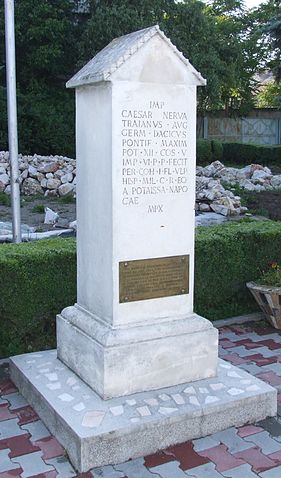 |
This is a file from the Wikimedia Commons. Information from its description page there is shown below.
Commons is a freely licensed media file repository. You can help.
|
Summary
| DescriptionMilliarum of Aiton, modern copy erected in Turda, Romania in 1993.jpg |
English: Copy of the Roman milliarium discovered in Aiton commune, near Cluj-Napoca, Romania, dating from 108 AD and showing the construction of the road from Potaissa to Napoca, by demand of the Emperor Trajan. It indicates the distance of ten thousand feet (P.M.X.) to Potaissa. It is the first epigraphical attestation of the settlements of Potaissa and Napoca in Roman Dacia. This monument was erected in June 1993 in front of the Turda Post Office (Dec. 1, 1918 Street). The complete inscription is: "Imp(erator)/ Caesar Nerva/ Traianus Aug(ustus)/ Germ(anicus) Dacicus/ pontif(ex) maxim(us)/ (sic) pot(estate) XII co(n)s(ul) V/ imp(erator) VI p(ater) p(atriae) fecit/ per coh(ortem) I Fl(aviam) Vlp(iam)/ Hisp(anam) mil(liariam) c(ivium) R(omanorum) eq(uitatam)/ a Potaissa Napo/cam / m(ilia) p(assuum) X". The inscription was recorded in Corpus Inscriptionum Latinarum, vol.III, the 1627, Berlin, 1863.
Español: Reproducción moderna con el texto de CIL III 1627, procedente de Aiton (Rumanía), que reza: "Imp(erator)/ Caesar Nerva/ Traianus Aug(ustus)/ Germ(anicus) Dacicus/ pontif(ex) maxim(us)/ (sic) pot(estate) XII co(n)s(ul) V/ imp(erator) VI p(ater) p(atriae) fecit/ per coh(ortem) I Fl(aviam) Vlp(iam)/ Hisp(anam) mil(liariam) c(ivium) R(omanorum) eq(uitatam)/ a Potaissa Napo/cam / m(ilia) p(assuum) X"
Română: Copia miliarului descoperit în comuna Aiton datând din anul 108 e.n. care atestă construirea din porunca împăratului Traian, a drumului de la Potaissa la Napoca. El indică distanța de zece ori o mie de pași (P.M.X.) până la Potaissa. Este cea dintîi menționare epigrafică a localităților Potaissa și Napoca. Acest monument a fost ridicat în iunie 1993 în fața Poștei din Turda (strada 1 Decembrie 1918). Inscripția completă este: "Imp(erator)/ Caesar Nerva/ Traianus Aug(ustus)/ Germ(anicus) Dacicus/ pontif(ex) maxim(us)/ (sic) pot(estate) XII co(n)s(ul) V/ imp(erator) VI p(ater) p(atriae) fecit/ per coh(ortem) I Fl(aviam) Vlp(iam)/ Hisp(anam) mil(liariam) c(ivium) R(omanorum) eq(uitatam)/ a Potaissa Napo/cam / m(ilia) p(assuum) X". Inscripția a fost înregistrată în „Corpus Inscriptionum Latinarum”, vol.III, textul 1627, Berlin, 1863.
|
| Date |
7 June 2006 |
| Source |
Own work |
| Author |
User:CristianChirita |
|
Camera location
|
46° 34′ 8.84″ N, 23° 47′ 9.37″ E
|
View this and other nearby images on: Google Maps - Google Earth - OpenStreetMap |
( Info)46.569122222222;23.785936111111 |
Licensing
| Public domainPublic domainfalsefalse |
 |
I, the copyright holder of this work, release this work into the public domain. This applies worldwide.
In some countries this may not be legally possible; if so:
I grant anyone the right to use this work for any purpose, without any conditions, unless such conditions are required by law.Public domainPublic domainfalsefalse
|
File usage
The following pages on Schools Wikipedia link to this image (list may be incomplete):
SOS Children's Villages has brought Wikipedia to the classroom. SOS Children's Villages believes education is an important part of a child's life. That's why we ensure they receive nursery care as well as high-quality primary and secondary education. When they leave school, we support the children in our care as they progress to vocational training or higher education. Find out how you can help children in other countries.



